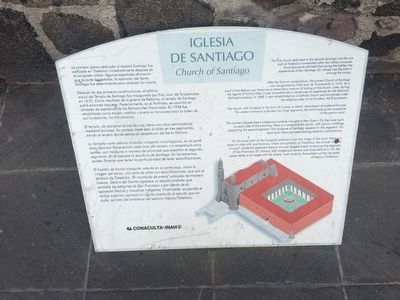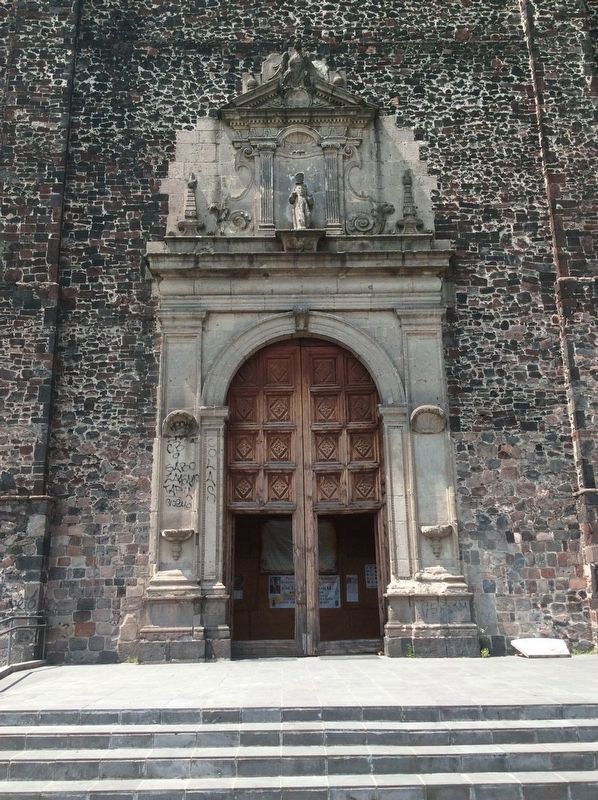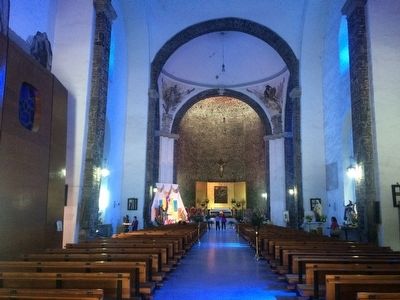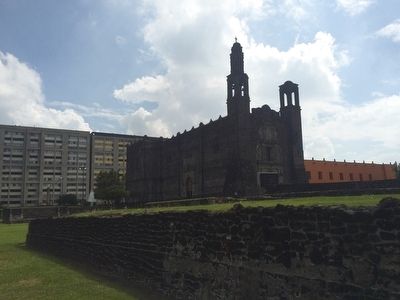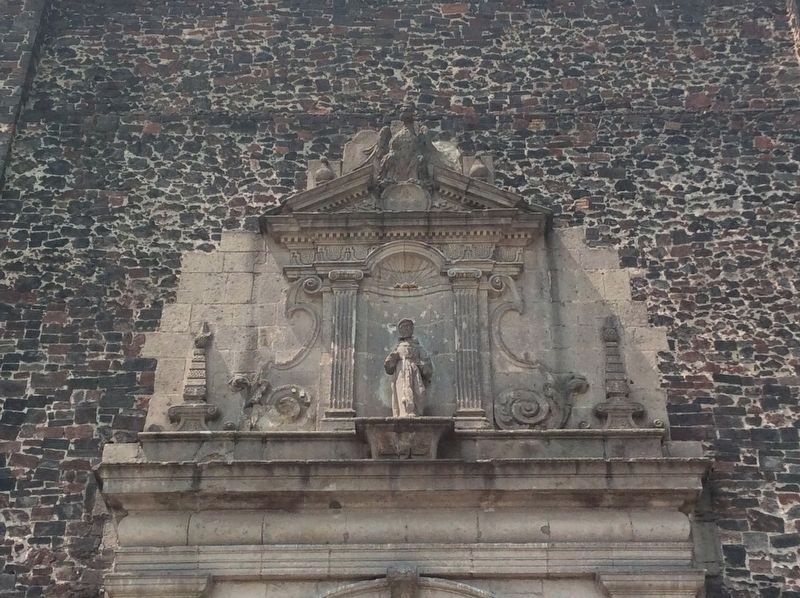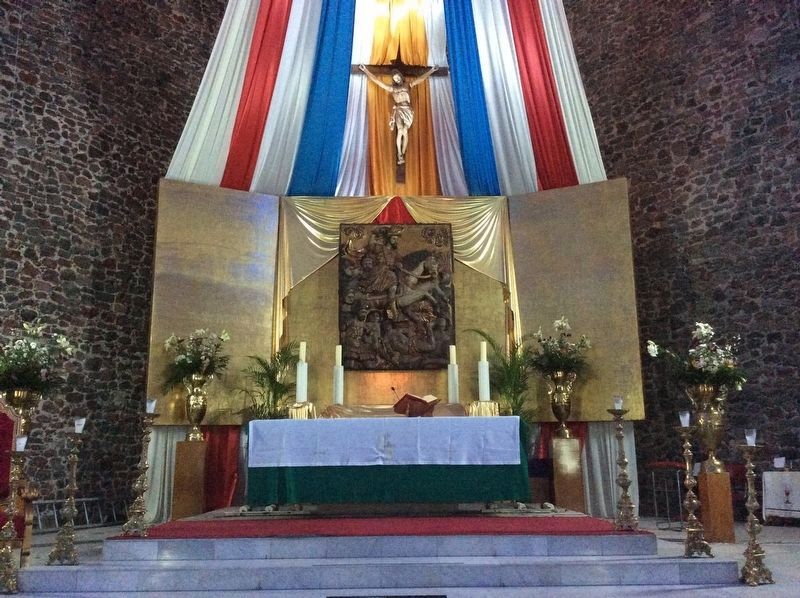Colonia Tlatelolco in Ciudad de México, Mexico — The Valley of Mexico (The Central Highlands)
Church of Santiago
Iglesia de Santiago
La primera iglesia dedicada al Apóstol Santiago fue edificada en Tlatelolco inmediatamente después de la conquista militar. Algunos españoles afirmaron que durante las batallas, al aparición del Santo Santiago fue determinante para alcanzar la victoria.
Después de dos primeras construcciones, el edificio actual del Templo de Santiago fue inaugurado por Fray Juan de Torquemada en 1610. Como resultado de la guerra de Reforma, el templo de Santiago sufrió enormes saqueos. Posteriormente, en el Porfiriato, se convirtió en almacén de explosivos de los Ferrocarriles Nacionales. En 1948 fue rehabilitado como templo católico y puesto en funciones bajo la orden de sus fundadores, los franciscanos.
El templo, en forma de cruz, tiene una clara reminiscencia medieval europea. Su portada oeste está dividida en tres segmentos, siendo el tercero donde estaba el receptáculo del Santo Patrono.
La fachada norte ostenta símbolos indígenas novohispanos, en la parte baja, aparece flanqueando cada lado del acceso, un receptáculo para santos, con molduras a manera de columnas que soportan el segundo segmento. El él aparece la escultura de Santiago. En los extremos, existen floreros que tienen la particularidad de tener escarificaciones.
El frontón de forma triangular ostenta en su parte baja, sobre la imagen del santo, una serie de ortas con escarificaciones, que son el símbolo de Tlatelolco, “El montículo de arena” colocado de manera inversa. Dentro del frontón aparece un escudo ovalado que contiene los estigmas de San Francisco y por detrás de él, aparece flechas y macanas indígenas. Finalmente, ocupando el vértice superior, aparece un águila sujetando el escudo que sin duda, se trata del emblema del señorío México-Tlatelolco.
The first church dedicated to the Apostle Santiago was the one built at Tlatelolco immediately after the military conquest. Some Spaniards affirmed that during the battles, the appearance of San Santiago (St. James) was decisive in winning the victory.
After the first two constructions, the current Church of Santiago was inaugurated by Friar Juan de Torquemada in 1610. As a result of the Reform war, there was a tremendous amount of looting at the church. Later, during the regime of Porfirio Díaz, it was converted into a warehouse for explosives for the National Railroad company. In 1948, it was rehabilitated as a Catholic Church and functioned under the religious order of its founders, the Franciscans.
The Church, with its layout in the form
of a cross, is clearly reminiscent of medieval Europe. The western entrance is divided into three segments, the third holding the receptacle of the patron saint.
The northern facade bears indigenous symbols wrought in New Spain. On the lower part, on each side of the entrance, there is a receptacle for saints, with column moldings supporting the second segment. The sculpture of Santiago appears in this segment. On each end, there are vases distinguished by scarifications.
On the lower part of the triangular pediment over the image of the saint, there is a series of orles with scarifications, which are symbolic of Tlatelolco, the inverse “mound of sand”. Inside the pediment there is an oval shaped shield containing the stigmata of San Francisco (St. Francis) with indigenous arrows and clubs behind it. On the upper vertex is an eagle with the shield, most certainly the emblem of the city-state of Mexico-Tlatelolco.
Erected by Conaculta-INAH.
Topics. This historical marker is listed in these topic lists: Anthropology & Archaeology • Churches & Religion • Man-Made Features • Wars, Non-US. A significant historical year for this entry is 1610.
Location. 19° 27.074′ N, 99° 8.193′ W. Marker is in Ciudad de México. It is in Colonia Tlatelolco. The marker is at the northern entrance to the Church of Santiago Apostol on Eje Central near the intersection with Avenida Ricardo Flores Magón. Touch for map. Marker is in this post office area: Ciudad de México 06900, Mexico. Touch for directions.
Other nearby markers. At least 8 other markers are within walking distance of this marker. Tlatelolco Massacre of October 2, 1968 (within shouting distance of this marker); The Small Area of Tlatelolco (within shouting distance of this marker); Santiago Church (within shouting distance of this marker); From peaceful convent to bellicose military barracks (within shouting distance of this marker); Architectonic puzzle: The façade of Tecpan (within shouting distance of this marker); Tzompantli altar (“flag of heads”) of the north (within shouting distance of this marker); Battle of Tlatelolco (within shouting distance of this marker); Friar Bernardino Sahagún (within shouting distance of this marker). Touch for a list and map of all markers in Ciudad de México.
Credits. This page was last revised on April 17, 2020. It was originally submitted on January 5, 2016, by J. Makali Bruton of Accra, Ghana. This page has been viewed 484 times since then and 33 times this year. Photos: 1. submitted on January 5, 2016, by J. Makali Bruton of Accra, Ghana. 2. submitted on August 12, 2017, by J. Makali Bruton of Accra, Ghana. 3, 4. submitted on January 5, 2016, by J. Makali Bruton of Accra, Ghana. 5, 6. submitted on August 12, 2017, by J. Makali Bruton of Accra, Ghana.
